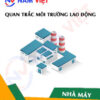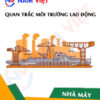Occupational Environment Monitoring at Stainless Steel Manufacturing Factory
99,000 ₫
Note: The above price is calculated for one sample; the price may fluctuate depending on the area of the environment to be monitored and market movements. For more accurate pricing support, please refer to the price list or contact our consulting staff directly.
Environmental monitoring of a stainless steel manufacturing factory is a session of collecting, analyzing, and evaluating factors at the workplace that may be harmful to workers’ health.
Table of Contents
Toggle1. Overview of Stainless Steel Manufacturing Factories
a. What is a stainless steel manufacturing factory?
A manufacturing factory for stainless steel is an industrial facility specialized in producing and processing stainless steel products. Stainless steel is a type of corrosion-resistant steel alloy mainly composed of iron, carbon, and certain elements such as chromium, nickel, manganese, and molybdenum. It has corrosion resistance, heat resistance, and high aesthetic value, making it widely used in various industries and applications.
Stainless steel manufacturing factories play a crucial role in supplying stainless steel products to industries such as construction, automotive, aviation, electronics, food, and many other sectors.

b. Production stages in stainless steel manufacturing factories
In a stainless steel manufacturing factory, there are key stages to produce and process stainless steel into finished products. The following are common stages in the stainless steel production process:
- Material preparation: First, the main materials for producing stainless steel, including steel and alloying elements (such as chromium, nickel, manganese, and molybdenum), are prepared and processed to create stainless steel alloys.
- Blast furnace process: This step removes impurities and reduces harmful element concentrations in the steel material.
- Heating and rolling: Steel materials undergo heating and rolling to produce stainless steel sheets of desired thickness and size.
- Cutting and processing: Stainless steel sheets are then cut into desired dimensions and shapes. Cutting technologies may include plasma cutters, laser cutters, or circular saws to achieve high precision.
- Surface finishing: Surface processing includes grinding, polishing, or surface protection to create smooth, shiny, and corrosion-resistant surfaces.
- Welding: Welding is used to join stainless steel pieces together to form finished products such as stainless steel pipes, tanks, or other metal structures.
- Quality inspection: Stainless steel products undergo quality checks to ensure they meet standards for strength, surface quality, and corrosion resistance.
- Packing and transportation: Finally, stainless steel products are packaged and prepared for delivery to customers and markets.

c. Machinery used in stainless steel manufacturing factories
Stainless steel manufacturing factories use various specialized machinery and equipment to carry out production and processing stages. Some common machinery includes:
- Plasma cutters: Used to cut stainless steel with high precision using the high-intensity plasma stream.
- Laser cutters: Provide precise and clean cuts during stainless steel processing by concentrating high-energy laser light on the material.
- Rolling machines: Used to thin and process stainless steel sheets by applying pressure and tensile force to achieve the desired thickness.
- Grinding and polishing machines: Used to process stainless steel surfaces, creating smooth and shiny finishes. Grinding machines may use wheels or discs for surface treatment.
- Bending and folding machines: Used to bend and fold stainless steel sheets into various shapes and structures using compressive force and bending technology.
- TIG/MIG welding machines: TIG (Tungsten Inert Gas) and MIG (Metal Inert Gas) welders are used for stainless steel welding, producing strong and reliable welds.
- Pipe forming and cutting machines: Used to process and cut stainless steel pipes into desired lengths and shapes.
- Polishing and cleaning equipment: Utilizes mechanical or chemical processes to achieve smooth and clean stainless steel surfaces.

d. Occupational diseases that may occur for workers in stainless steel manufacturing factories
Workers in stainless steel manufacturing factories may be exposed to harmful environmental factors, which can cause health issues. Some occupational diseases that workers may face include:
- Respiratory diseases: Exposure to dust and metal fumes during stainless steel processing and welding can cause respiratory problems, including pneumonia, sinusitis, asthma, and bronchitis.
- Skin diseases: Contact with compounds and cleaning agents can cause skin irritation, dermatitis, eczema, and other skin conditions.
- Endocrine disorders: Some metal compounds in stainless steel may affect the endocrine system, causing issues with the thyroid, pancreas, and reproductive system.
- Cardiovascular diseases: Heavy metal compounds can negatively affect the cardiovascular system, causing high blood pressure, arrhythmia, and heart diseases.
- Cancer: Certain metal compounds in stainless steel, such as hexavalent chromium, may pose a cancer risk, particularly if inhaled as fumes, dust, or liquid containing these compounds.
- Digestive diseases: Exposure to metal compounds in stainless steel can cause digestive disorders, gastritis, enteritis, and other gastrointestinal issues.
To ensure safety and protect workers’ health, personal protective equipment, safe working procedures, and strict compliance with environmental protection regulations are essential in stainless steel manufacturing factories.

e. Common types of stainless steel in the market
There are many common types of stainless steel used in various industries. Some of them include:
- Stainless steel 304: Also called 18-8 stainless steel, containing 18% chromium and 8% nickel. It has good corrosion resistance and is widely used in machinery manufacturing, food, and medical industries.
- Stainless steel 316: Contains 16-18% chromium, 10-14% nickel, and 2-3% molybdenum. Offers higher corrosion resistance than 304 stainless steel, especially in salt-containing environments. Commonly used in chemical, pharmaceutical, and marine industries.
- Stainless steel 430: Contains approximately 16-18% chromium. Has limited corrosion resistance and is mainly used for applications not requiring high corrosion resistance, such as smoke ducts, sinks, and decorative surfaces.
- Stainless steel 201: A non-magnetic stainless steel containing about 16-18% chromium and 3.5-5.5% nickel. Offers relatively good corrosion resistance and is often used in decorative applications, household appliances, and construction.
- Stainless steel 904L: Contains approximately 20-23% chromium, 4-5% nickel, and 1-2% molybdenum. Offers high corrosion resistance, particularly in acidic environments. Widely used in chemical, oil, and applications requiring strong acid resistance.

2. Overview of Occupational Environmental Monitoring Services
a. What is occupational environmental monitoring in stainless steel manufacturing factories?
Occupational environmental monitoring (or occupational environment measurement) in stainless steel manufacturing factories is the activity of collecting, assessing, and analyzing indicators of workplace environmental factors at the factory. This aims to implement timely measures, minimize environmental hazards to workers’ health, and prevent occupational diseases. Occupational environmental monitoring is a mandatory requirement for stainless steel manufacturing factories.
Occupational environmental monitoring is crucial for protecting and enhancing workers’ health because the main resource of a business, directly generating profit, is its workforce. Workers frequently exposed to risk factors or occupational hazards beyond allowed limits may suffer health effects and occupational diseases.
REGISTER FOR OCCUPATIONAL ENVIRONMENT MONITORING SERVICE
b. Nam Viet’s occupational environmental monitoring program
Nam Viet’s occupational environmental monitoring program is developed by environmental and occupational safety engineers. To ensure workers’ health and safety, the program uses modern measurement methods to monitor air, water quality, and microclimate, physical factors, dust, etc., in the workplace. This program is essential to ensure a safe working environment and protect workers’ health.
Additionally, Nam Viet’s monitoring program plays an important role in researching and developing solutions to improve workplace environmental quality. With the dedication and professionalism of its team, Nam Viet’s exclusive monitoring program has become a breakthrough in occupational safety management and environmental protection in Vietnam.

c. Standardization in occupational environmental measurement procedures
Standardization in Nam Viet’s occupational environmental measurement procedures is critical to ensuring accurate and reliable results. To guarantee precision and reliability, the program follows standards and procedures recognized by the Ho Chi Minh City Department of Health. This ensures collected data is highly reliable for evaluating workplace environments and making decisions to improve working conditions and protect workers’ health.
These standardized procedures also ensure that measurements are conducted by highly qualified monitoring specialists with years of experience, allowing managers and experts to trust results from An Toàn Nam Việt and make informed decisions to protect workers and the environment.
By applying standardization in measurement procedures, Nam Viet demonstrates its commitment to providing a safe working environment and protecting workers’ health while contributing to improving occupational safety and environmental management in Vietnam.
d. Occupational environmental monitoring report for stainless steel manufacturing factories
Occupational environmental monitoring results are prepared according to Form No. 04, Appendix III issued with Decree 44/2016/ND-CP and prepared in two copies: one copy sent to the contracting workplace and one retained by the monitoring organization.
The retention period for occupational environmental monitoring results is unlimited according to legal regulations.

e. Frequency of occupational environmental monitoring according to law
According to Clause 2 of Article 18, Law on Occupational Safety and Hygiene 84/2015/QH13, employers must organize occupational environmental monitoring to assess harmful factors at least once a year.
f. Deadline for submitting occupational environmental monitoring reports according to law
The deadline for submission is before December 31 each year. Enterprises at production facilities must submit occupational environmental monitoring reports to the local Department of Health where the enterprise’s headquarters and employees are located.
When there are changes in production technology or processes, or when upgrading facilities with potential new hazards to workers’ health, enterprises must update occupational hygiene records regarding harmful factors to be monitored.
g. Penalties for violations of occupational environmental monitoring by employers
According to Article 27 of Decree No. 12/2022/ND-CP dated 17/01/2022 on administrative penalties in labor, social insurance, and Vietnamese workers working abroad under contracts:
- Clause 2: Fines of 2,000,000 – 5,000,000 VND for employers who fail to publicly disclose monitoring results to workers at the monitoring site and management areas immediately after the results are available.
- Clause 3: Fines of 20,000,000 – 40,000,000 VND for employers who do not conduct occupational environmental monitoring to control health hazards to workers according to the law.
- Clause 4: Fines of 40,000,000 – 60,000,000 VND for employers who collude with monitoring organizations to commit fraud in occupational environmental monitoring, but not to the extent of criminal liability.
3. Harmful Environmental Factors for Workers in Stainless Steel Production Factories
Workers in stainless steel production factories may be exposed to several harmful environmental factors that can cause health issues. Below are some environmental factors that may be harmful in stainless steel production workplaces:
- Metal dust: Stainless steel processing can generate fine metal dust, such as Cr (chromium) dust and Ni (nickel) dust. Exposure to this metal dust can irritate the respiratory system and cause respiratory problems.
- Chemical fumes: During stainless steel production, chemicals such as sulfuric acid and nitric acid may be used. These fumes can irritate the eyes, nose, throat, and respiratory system.
- Welding fumes: Stainless steel welding produces fumes, including metal vapors and metal compounds, such as Cr vapor and Cr (VI) compounds. These welding fumes can irritate the respiratory system and cause respiratory issues.
- Noise: Machinery and production processes in the factory can generate high noise levels, causing stress and affecting hearing.
- Temperature and working conditions: Stainless steel factories may have hot, humid, or otherwise harsh working conditions, which can affect workers’ health and comfort.
- Flooring materials: Factory floors may contain additives or be slippery, posing occupational safety hazards.
REGISTER FOR OCCUPATIONAL ENVIRONMENT MONITORING SERVICE
4. Measures to Improve the Work Environment in Stainless Steel Production Factories
To improve the working environment in stainless steel factories and protect workers’ health, the following measures can be applied:
- Ensure ventilation and exhaust systems: Provide sufficient fresh and cool air in the workspace to reduce the accumulation of chemical fumes and metal dust.
- Use vacuum extraction systems: Place vacuum extraction devices near processing areas to capture and remove metal dust and chemical fumes at the source.
- Limit exposure to fumes and metal dust: Ensure workers are equipped with personal protective equipment such as masks, safety goggles, helmets, and appropriate clothing to protect against fumes and dust.
- Ensure welding safety: Use shields, welding fume extraction equipment, and safe welding procedures to control welding fumes and noise.
- Air quality monitoring: Conduct regular checks of the factory air quality to ensure concentrations of harmful substances like chemical fumes and metal dust do not exceed safe limits.
- Training and awareness: Provide training for workers on workplace safety, personal protective equipment, safe work procedures, and environmental hazard recognition in stainless steel production factories.
- Follow regulations and procedures: Comply with environmental protection and occupational safety regulations, including proper use of cleaning agents, proper waste management, and regular maintenance of equipment and machinery.
- Monitor workers’ health: Conduct periodic health checks to track workers’ health and detect occupational disease-related issues early.
- Regularly conduct occupational environment monitoring in factories, collect and analyze harmful factors affecting workers, and adjust to reduce risks to prevent occupational diseases.
5. Benefits of Regular Monitoring in Stainless Steel Production Factories
An Toàn Nam Việt provides businesses with excellent benefits when using occupational environment monitoring services according to Decree 44/2016/NĐ-CP on the management and control of harmful factors in the workplace affecting employees.
- Businesses can proactively control harmful factors in their factories.
- Receive recommendations on measures to reduce harmful factors and improve the quality of the work environment.
- Indirectly protect human resources, a key factor in business development.
- Minimize the impact of occupational diseases on workers’ health, thereby reducing future treatment costs.
- Improved worker health leads to better product quality and ensures stable production output.
- Comply with labor safety laws, avoiding legal risks.
- Enhance credibility and professionalism in all aspects, thereby elevating the company’s brand.
Nam Viet’s environmental monitoring service is a solution to minimize occupational disease risks, contributing to a clean and high-quality working environment.

6. Nationwide Occupational Environment Monitoring Center
Nam Viet Occupational Environment Monitoring Center is a professional unit specializing in monitoring and measuring workplace environmental quality throughout all provinces of Vietnam. With an experienced team of environmental monitoring specialists, the center uses modern measuring equipment to ensure accuracy and reliability.
In addition to providing monitoring services, the center assists clients in planning, managing, and following up on occupational environment issues. With the motto “customer-centered,” the center prioritizes client satisfaction, meets all client needs, and commits to providing the best solutions.
REGISTER FOR OCCUPATIONAL ENVIRONMENT MONITORING SERVICE
With investments in technology, equipment, and human resources, Nam Viet’s monitoring center has become a reputable unit in occupational environment monitoring in Ho Chi Minh City, with the following goals:
- We value brand reputation and the quality of our service products.
- We provide clients with the best and most suitable solutions.
- With a team of experienced Masters and Engineers committed to protecting the environment and benefiting businesses.
- Clients of Nam Viet Environmental Monitoring will receive professional services from experts in the field, as well as the best cost advantages.
The occupational environment monitoring process at Nam Viet includes the following steps:
- Before monitoring, ensure all equipment is calibrated and adjusted according to legal regulations.
- Carry out the monitoring process as committed to the Department of Health.
- Report accurate monitoring results to employers.
- If monitoring results indicate unsafe conditions for workers, Nam Viet will provide corrective solutions, and the factory will implement:
- Implement measures to improve working conditions, minimizing harmful factors and preventing occupational diseases.
- Organize medical check-ups to detect occupational and work-related illnesses early for employees in unsafe work environments.
- Provide compensation in kind for workers according to labor law regulations.

7. Occupational Environment Monitoring Price List
To help businesses conduct professional and effective occupational environment monitoring, Nam Viet provides clients with a detailed and reasonably priced service price list.
- Our price list provides detailed information on the costs of all monitoring services, including transportation, measurement, analysis, and reporting. Clients can be confident in the accuracy and reliability of the monitoring reports provided.
- We are committed to offering competitive and reasonable prices while providing prompt and professional consultation on any service-related inquiries.
- With Nam Viet’s price list, clients can easily select services that best meet their needs. We guarantee maximum satisfaction with professional service quality.
No comments yet












Review Occupational Environment Monitoring at Stainless Steel Manufacturing Factory
There are no reviews yet.